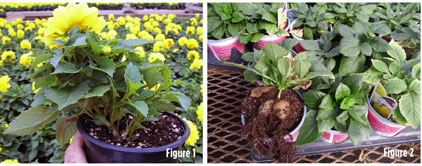2/27/2013
The Doctor Is In!: Keys to Successfully Grow Dahlias
Dr. Roger Styer
Now that March is here, we get questions about how to grow dahlias, which are a great late spring and summer crop. Varieties can be grown in a wide range of pot sizes, from 4-in. to 10-in. or larger containers and consumers love the color range. Every year, growing mistakes are made relating to too small plants, floppy plants at the store and collapse of plants as flowers start to show, to name just a few.
For growers rooting cuttings, stick them deep! Make sure the lowest pair of leaves is touching just below the soil surface so they will root up the stem. Rooting hormone can be used if needed. Dahlia cuttings root quickly in three weeks, so don’t delay transplanting. Provide long days (14-hour daylength) or night interruption to prevent tuber formation, which takes away energy from vegetative growth and causes too early flowering.
When it’s time to transplant liners, plant them deep! You want the lowest pair of leaves to be just below the soil surface so more roots will form and keep plants from being floppy when flowering. Notice a trend here? Stick and transplant deep to avoid floppy finished plants! Growth regulators applied later on won’t make up for the mistake of not transplanting deep (see Figure 1).
Pinch plants in 5-in. or larger pots two to three weeks after transplanting, leaving four leaves. Smaller pots don’t need pinching. For more flowering when it’s time to ship, pinch out the center flower bud when it appears, but flowering will be delayed five to seven days. However, your customers will thank you by buying more plants due to more flowers on the plant.

Prior to Week 13, provide long-day lighting of 13 to 14 hours to prevent tuber formation and too small plants. Use daylength extension with HID, incandescent or compact fluorescent lights. Dahlias will flower faster under shorter days, but you get small plants that don’t fill out the pots with small flowers. Tuber formation starts with daylengths less than 12 hours and takes away energy for vegetative growth. You can see the tuber formation along with flowering and plant height with different daylengths in Figure 2. Once days are longer, plants have more vegetative growth before flowering, so growers need to use more growth regulators. Use daminozide (B-Nine or Dazide) sprays at 1,500 to 2,500 ppm about two to three weeks after transplanting, but stop when flower buds are visible or you may delay flowering. A paclobutrizole (Bonzi, Piccolo, Paclo) drench at 3 to 5 ppm or uniconizole (Sumagic, Concise) drench at 0.5 to 1.0 ppm when plants are up to saleable size and starting to flower will control further growth.
Keep growing media pH 6.0 to 6.2 and EC 1.5 to 2.0 (SME). Feed with 100 to 150 ppm N from 15-5-15 or 17-5-17, both of which have calcium and magnesium. It’s important to avoid overfeeding dahlias, as this may cause greater susceptibility to root rots when plants are budding and flowering. Keep media consistently moist without drying to wilt. Hard dry-downs can lead to greater Pythium susceptibility if plants are then heavily irrigated. Ideal growing temperatures are 65 to 70F (18 to 21C) day, 63 to 65F (17 to 18C) nights. High temperatures averaging more than 75F ADT may delay flowering and reduce flower size. Use maximum light intensity and avoid shading from overhead crops.
Key insect pests include aphids, thrips, whiteflies and occasionally spider mites. Key root rot diseases include Pythium, Phytophthora and Fusarium. Fungicide drenches to control these root rots are recommended monthly or right before flower buds appear. Powdery mildew can also be a problem. Select resistant varieties such as Dahlinova and Dahlinova Hypnotica, and spray when needed. Make sure to rotate chemicals for best control of insects and diseases, and always follow label directions.
GT
Dr. Roger Styer is Technical Rep in North America for Fides-Oro and can be reached by phone at (630) 842-1629, email at r.styer@fides-oro.com or through the Fides-Oro website at www.fides-oro.com by clicking on the “Ask the Doctor” banner.